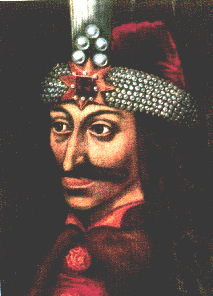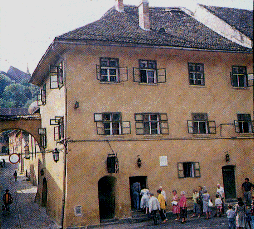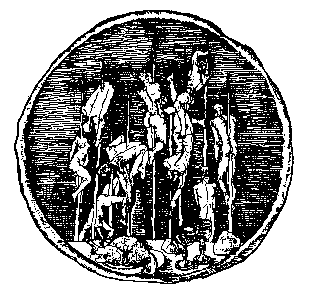
Vlad Dracula's portrait
(oil painting, Ambras Castel, Tyrol) |
| |
A group of Wallachian noblemen bringing with them a princely sceptre made most people living in Nurnberg, the city of imperial diets, defy the cold weather and take part, on February 8, 1431 in an important historic event: emperor Sigismund of Luxemburg conceded the rulership in Wallachia to Vlad who has been living at his court for eight years. That very day, emperor Sigismund gave his favourite a necklace and a golden medalion with a dragon engraved on it, the badge of the knights of the Order bearing the name of the mystical animal.
Waiting for coronation, Vlad and his family went to Sighisoara, Transylvania, where he set up a mint. For the first two monetary emissions, Vlad used his signet emblem, the dragon. Therefore, the Romanians whose word stock is mainly Latin, nicknamed him Dracul - Dracula (from the Latin Draco-Onis. In Romanian Drac means Devil. This nickname turned into a surname for his descendants, Vlad, his second son being known as such. He spend his childhood in Sighisoara, was taken hostage by Turks, then went to his uncle Iancu de Hunedoara, a Romanian nobleman (whose daughter Vlad later married) becoming prince of Wallachia on August 22, 1456).

Vlad Dracula's childhood home |
| |
Known as one of the most dreaded enemies of the Ottoman Empire, Vlad Dracula started organizing the state, the army, the law, applying death penalty by impaling all those he considered enemies: highwaymen, robbers, beggars, cunning priests, treacherous noblemen, usurper Saxons, who tried to replace him either by his cousin Dan cel Tanar (Dan the Young) or by his natural brother Vlad Calugarul (Vlad the Monk). |
| The Ottoman historians nicknamed him Vlad Tepes, as he came to be known in Romanian historiography, but he used to sign with his father's name, Dracula. This is testified in Bucharest's first documentary mentioning, dated September 20, 1459 and in the portrait of Odhsenbach Stambuch from Stuttgart.
Arrested by his coming brother-in-law, Matei Corvin, because of a treacherous malvolent, Vlad Dracula spent more than ten years in prison, at Visegrad near Buda. Back to the throne in 1476 with the help of Stefan cel Mare (Stephen the Great), prince of Moldavia, of the Senate of the Republic of Venice and of the pope Sixt 4th, Vlad resumes his fight against the Ottomans but towards the end of the same year is killed at Snagov by Laiota Basarab who followed him to the throne of Wallachia.
Last update: 1999, August 20 |



